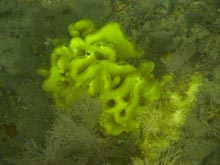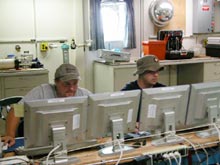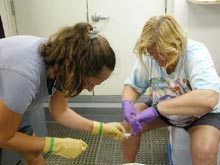
Tara Pitts (l) and Kathleen Janda (r) of HBOI take sponge samples for analysis. Kathleen is attempting to culture cells that may yield important lifesaving compounds. Click image for larger view.
What You Can't See Might Cure You
September 13, 2003
Gary K. Wolfe
Marine and Environmental Education
Eau Gallie High School
Rollins College, Brevard, FL
Most of us live in a world that makes sense only if we can see it with our own eyes. That is not necessarily the case for Kathleen Janda, a microbiologist in the Division of Biomedical Research at Harbor Branch Oceanographic Institution. Her passion is the life you cannot see.
On board the NOAA Ship Ronald H. Brown, Kathleen examines the bacteria and various other microbes associated with sponges. When conducting research on organisms for possible pharmaceuticals, you must be aware that the actual organism collected may not be the bioactive compound you are seeking. It could be bacteria, fungi or any other component of the organism that makes a useful compound. Whether it be from the food that a sponge consumes, an epibiont that associates itself with the organism, or some type of symbiont, all possibilities must be examined as the source of lifesaving compounds.
From a pharmaceutical manufacturer's point of view, locating and manufacturing organisms that can produce lifesaving compounds would be ideal. The mass removal of organisms to be harvested for pharmaceutical compounds would prove detrimental to an ecosystem. A better method is to investigate life forms for clues, identify bioactive compounds, and then attemp to produce them en masse at a production facility. This assumes that the bacteria, for example, that is producing the disease-fighting compound can be cultured (grown in a lab). Only 1-4% of known bacteria can be cultured using current techniques. One of Kathleen's projects involves finding new ways to culture "unculturable" bacteria. After all, the other 96% could potentially produce bioactive compounds for the treatment of cancer and other human diseases.
Intending to collect more samples for Kathleen and the other scientists today, we are diving along a set of long parallel ridges known as the "Twin Ridges." These features are located approximately 100 mi south of Panama City along Florida's panhandle. The ridges rise to within 200 ft of the surface, making them prime real estate for all sorts of benthic (bottom-dwelling) organisms. The chief scientists are the only people on board who have visited the site before, so they are directing the pilot to the specific area and specimens they wish to collect. In a true team effort, all of the members of the scientific party will begin rotating two-hour shifts to assist the chief scientists in the ROV (remotely operated vehicle) control van during dives. We will all get a chance to see what it is like to be in the van during a dive, to see firsthand how the samples are collected, and to help record vital information.
I was actually able to observe the "show" first with Dr. Shirley Pomponi. The inside of the van is dark and there isn't a whole lot of room to maneuver. The only light comes from the monitors and the red lights in the room. With all the controls, monitors, and recording devices, there is barely enough room for four people. We observers were cramped into a corner taking notes on the NOAA Ocean Explorer dive log sheets. The task, which was not difficult, gave me and the other observers plenty of time to watch the events on the monitors. Watching the pilot "fly" the vehicle was pretty cool! It was somewhat similar to a simulator ride at a theme park. It was as close as you can get to the ocean floor without actually being there. The co-pilot sits in the seat to the left of the pilot, maneuvering the ROV's manipulator arm with a jointed joystick.
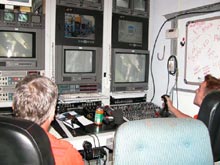
Sonsub Inc. crew members Greg Wardwell (l) and Lucas Cribley (r) make skilled maneuvers during today's dive. Greg served as the pilot, conducting overall movement of the ROV, and Lucas was the co-pilot, maneuvering the arms and cameras. Click image for larger view.
At the end of what seemed like a very long day, the ROV conducted a total of three dives, and was back on deck around 1 pm. By the time we finished processing and photographing the samples, it was close to 11:15 pm. The results of today's dives included 19 collected samples, two of which were Clathria sponges. The Harbor Branch scientists have never collected these sponges and were very excited to see them in the buckets after unloading the ROV. Also as a result of today's dives, we have plenty of photographs and a new batch of organisms for Kathleen and the other scientists to inspect as they seek potential biomedical products.
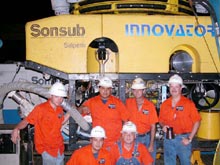
The Sonsub Inc. crew poses for a quick group photo during shift change. Back row (l to r): Lucas Cribley, Tim Jaramillo, Lee Goodell, Maurice Rivard. Front row: Ray Maza, Greg Wardwell. Click image for larger view.
Exploration is a Team Effort: Sonsub Inc. and C&C Technologies
Gary K. Wolfe
Marine and Environmental Education
Eau Gallie High School
Rollins College Brevard
As the visiting educator on this mission, it is my job to observe how marine field research operates, and how it can be incorporated into marine science curriculums. One of the things that I always try to instill in my students is that the quality of the science is only as good as the instruments you use. I feel strongly that this statement not only applies to the instruments at your disposal, but also to the people you work with.
A good example of this is the use the ROV (remotely operated vehcile) Innovator to survey and sample benthic (bottom) habitats. The successful operation of this equipment is credited to the six-member team from Sonsub Inc. and the two-person C&C Technologies team. For the past six days, I have seen them work tirelessly together to make sure that the Innovator is ready to go when the scientists need it. Initially, all were aware of the learning curve involved with a mission like this one. The logistics alone are enough to make you want to throw up your hands in frustration at times. Nevertheless, the perseverance, professionalism, and teamwork demonstrated by this eight-member group have the scientists well on their way to accomplishing all of the mission's major objectives.
Before the Innovator is launched into the water, the exact position of the ship must be known. A GPS (global positioning system) is used to provide an exact fix on the vessel. Once the Innovator is in the water, its exact position in relation to the ship must be determined and followed. This is no easy task, as I have come to learn. This difficult job belongs to Geoff Ellett and Jesse Harper of C&C Technologies.
"The greatest challenge on this expedition has been to integrate our systems with that of the Sonsub team. It has taken a few days to do this, but all seems to be working rather smoothly at this time," Geoff noted. At the same time, working as a team to solve the integration problems has been the most rewarding part of the trip. "Knowing that you can use your cumulative knowledge to identify and solve a problem is the greatest satisfaction," he said.
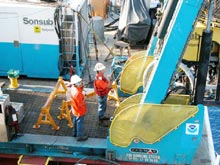
Ray Maza (l) and Lee Goodell (r) during a morning launch of the Innovator ROV. Ray wears a headset to communicate with the pilot inside the van, while Lee gives instructions to hold the ROV steady. Click image for larger view.
In control of the ROV and its support systems is the six-member Sonsub Inc. crew, which includes Lee Goodell, Lucas Cribley, Maurice Rivard, Greg Wardwell, Ray Maza and Tim Jaramillo. In speaking with the members of the Sonsub Inc. crew, I got a sense of shared pride and confidence.
"It's never boring, and the scientists' work gives us a chance to try our hands at something a little different than the support we provide on oil rigs," said one crew member during a discussion at breakfast this morning. "If we see a six-gilled deep-water shark swim by on the rigs, we can't go take a look at it! We have to stay focused on our supporting task for the company. On this trip, though, if we saw the same shark, the scientists would probably want us to chase it."
The men of the Sonsub team definitely enjoy the work they do. "The travel is exciting, the pay is good, and we get to do something that many do not get a chance to," said another crew member.
After breakfast, one of the Sonsub Inc. supervisors took me on a tour of the ROV Innovator's components and explained the integration of the major systems that make the vehicle work. He explained that a three-person team operates the ROV (with two teams working 24 hours a day, in 12-hr shifts). One person serves as the pilot, who is in control of the ROV, and another serves as the co-pilot, who oversees underwater operations and controls the two manipulator arms. A third person stays outside of the van to make sure that the support equipment is functioning properly.
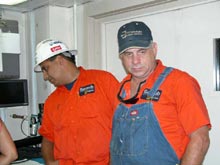
Sonsub Inc. team members Tim Jaramillo (l) and Greg Wardwell (r) are interested in the scientists' work and wait to see what was brought up from the dive. Click image for larger view.
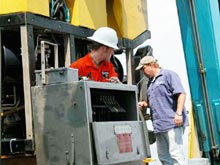
A pictorial example of how well the Sonsub Inc. and C&C Technologies crews worked together. Lucas Cribley of Sonsub Inc. (l) and Geoff Ellett (r) of C&C Technologies make adjustments to the ROV on deck. Click image for larger view.
Exploration is a team effort, and all must commit themselves to their assigned tasks. On the NOAA Ship Ronald H. Brown, the various teams are working well in unison, resulting in a successful and rewarding expedition for all.
Sign up for the Ocean
Explorer E-mail Update List.






















